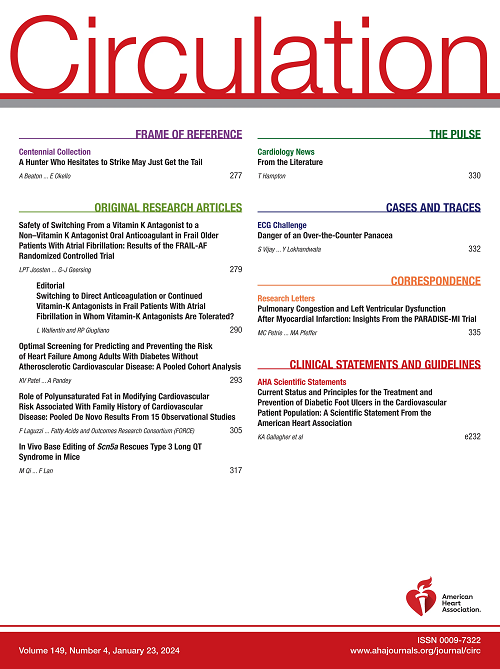成人心脏和心力衰竭单细胞剪接异构体图谱。
IF 38.6
1区 医学
Q1 CARDIAC & CARDIOVASCULAR SYSTEMS
引用次数: 0
摘要
选择性剪接通过影响蛋白质编码序列、功能域和分子网络在正常心脏发育和心脏病中起着至关重要的作用。然而,人类心脏同种异构体景观的详细表征仍然不完整。方法利用长读单核RNA测序和计算分析,我们解剖了成人左心室全长异构体的异质性、表达模式和不同细胞类型、细胞状态和心脏状况的使用变化。我们应用计算机方法来评估鉴定同种异构体的功能相关性;利用逆转录定量聚合酶链反应和靶向扩增子测序验证了代表性心脏基因的异构体组成;并开发了一个web服务器,用于交互式导航我们的结果。结果数据显示,异构体异质性在心脏细胞系统中广泛存在,可作为校正人类心脏分子库的转录后缓冲系统。在健康的左心室中,约30%的细胞类型特异性基因是多型的,使用针对细胞类型特异性程序定制的多个同种异构体。在普遍表达的基因中,bbb300表现出不同的异构体使用,具有细胞类型特异性。与心力衰竭相比,心肌细胞中的379个基因表现出明显的同种异构体使用变化,预测其中大多数通过直接改变蛋白质编码序列和内含子保留与非蛋白质编码生物型之间的切换来改变蛋白质编码结果。相反,细胞状态特异性程序倾向于操作与细胞状态变化相关的单型基因。此外,我们的数据揭示了心脏微环境中基质细胞和免疫细胞类型中心力衰竭相关的差异异构体使用事件。结论:通过长读单核RNA测序和综合计算分析,我们获得了正常成人心脏和心力衰竭剪接异构体的完整图谱。结果表明,同种异构体在缓冲核心细胞程序和促进疾病相关的细胞状态中的关键作用。这些细胞特异性同种异构体的完整细节可作为下游翻译和机制研究的重要参考,并可在我们的在线数据门户网站https://github.com/gaolabtools/heart-isoform-atlas上获得。本文章由计算机程序翻译,如有差异,请以英文原文为准。
Single-Cell Splicing Isoform Atlas of the Adult Human Heart and Heart Failure.
BACKGROUND
Alternative splicing plays crucial roles in normal heart development and cardiac disease by influencing protein-coding sequences, functional domains, and molecular networks. However, a detailed characterization of the human heart isoform landscape remains incomplete.
METHODS
Leveraging long-read single-nucleus RNA sequencing and computational analysis, we dissected full-length isoform heterogeneities, expression patterns, and usage shifts across cell types, cell states, and cardiac conditions of the adult left ventricle. We applied in silico approaches to assess the functional relevance of identified isoforms; validated isoform compositions of representative cardiac genes using reverse transcription quantitative polymerase chain reaction and targeted amplicon sequencing; and developed a web server for interactive navigation of our results.
RESULTS
The data revealed that isoform heterogeneity is widespread in the cardiac cellular system, serving as a posttranscriptional buffer system that calibrates the molecule reservoirs in human hearts. In healthy left ventricles, ≈30% of cell type-specific genes were polyform, using multiple isoforms tailored to cell type-specific programs. Among ubiquitously expressed genes, >300 showed differential isoform usage with cell type specificity. Compared with heart failure, 379 genes in cardiomyocytes demonstrated marked isoform usage shifts, most of which are predicted to change protein coding outcomes through direct changes in protein coding sequences and switches between intron retention and non-protein-coding biotypes. In contrast, cell state-specific programs tend to operate on monoform genes associated with changes among cell states. In addition, our data revealed heart failure-associated differential isoform usage events in stromal and immune cell types in the cardiac microenvironment.
CONCLUSIONS
We present a comprehensive atlas of splicing isoforms in the normal adult heart and heart failure through long-read single-nucleus RNA sequencing and comprehensive computational analyses. The results suggest crucial roles of isoforms in buffering core cellular programs and contributing to disease-associated cell states. The full-length details of these cell-specific isoforms serve as an important reference for downstream translational and mechanistic studies and are available on our online data portal at https://github.com/gaolabtools/heart-isoform-atlas.
求助全文
通过发布文献求助,成功后即可免费获取论文全文。
去求助
来源期刊

Circulation
医学-外周血管病
CiteScore
45.70
自引率
2.10%
发文量
1473
审稿时长
2 months
期刊介绍:
Circulation is a platform that publishes a diverse range of content related to cardiovascular health and disease. This includes original research manuscripts, review articles, and other contributions spanning observational studies, clinical trials, epidemiology, health services, outcomes studies, and advancements in basic and translational research. The journal serves as a vital resource for professionals and researchers in the field of cardiovascular health, providing a comprehensive platform for disseminating knowledge and fostering advancements in the understanding and management of cardiovascular issues.
 求助内容:
求助内容: 应助结果提醒方式:
应助结果提醒方式:


